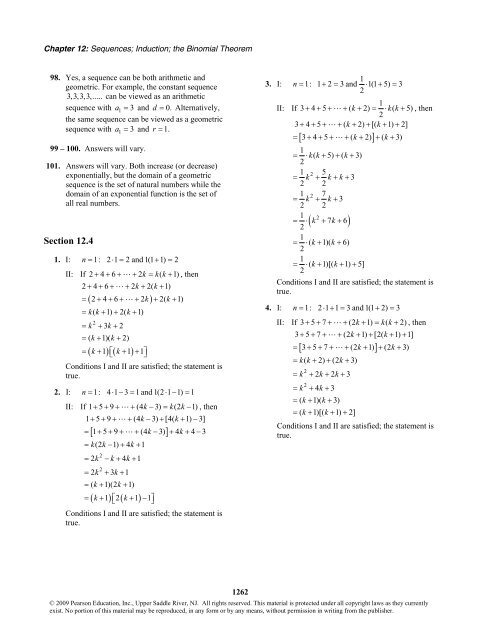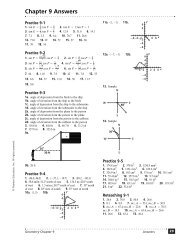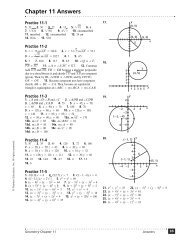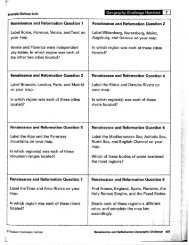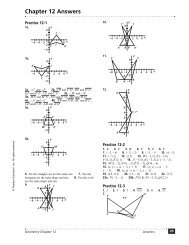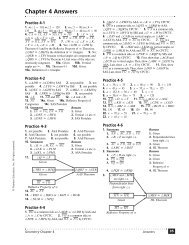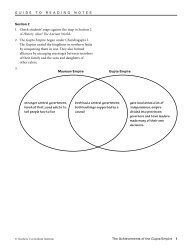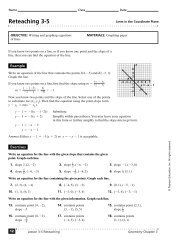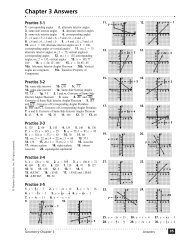Chapter 12 Sequences; Induction; the Binomial Theorem
Chapter 12 Sequences; Induction; the Binomial Theorem
Chapter 12 Sequences; Induction; the Binomial Theorem
You also want an ePaper? Increase the reach of your titles
YUMPU automatically turns print PDFs into web optimized ePapers that Google loves.
<strong>Chapter</strong> <strong>12</strong>: <strong>Sequences</strong>; <strong>Induction</strong>; <strong>the</strong> <strong>Binomial</strong> <strong>Theorem</strong><br />
98. Yes, a sequence can be both arithmetic and<br />
geometric. For example, <strong>the</strong> constant sequence<br />
3,3,3,3,..... can be viewed as an arithmetic<br />
sequence with a 1 = 3 and d = 0. Alternatively,<br />
<strong>the</strong> same sequence can be viewed as a geometric<br />
sequence with a 1 = 3 and r = 1.<br />
99 – 100. Answers will vary.<br />
101. Answers will vary. Both increase (or decrease)<br />
exponentially, but <strong>the</strong> domain of a geometric<br />
sequence is <strong>the</strong> set of natural numbers while <strong>the</strong><br />
domain of an exponential function is <strong>the</strong> set of<br />
all real numbers.<br />
Section <strong>12</strong>.4<br />
1. I: n = 1: 2⋅ 1= 2 and1(1 + 1) = 2<br />
II: If 2+ 4+ 6+ + 2 k = k( k+<br />
1) , <strong>the</strong>n<br />
2+ 4+ 6+ + 2k+ 2( k+<br />
1)<br />
= ( 2+ 4+ 6+ + 2k)<br />
+ 2( k+<br />
1)<br />
= kk ( + 1) + 2( k+<br />
1)<br />
2<br />
= k + 3k<br />
+ 2<br />
= ( k + 1)( k + 2)<br />
= ( k+ 1) ⎡⎣( k+ 1)<br />
+ 1⎤⎦<br />
Conditions I and II are satisfied; <strong>the</strong> statement is<br />
true.<br />
2. I: n = 1: 4⋅1− 3= 1and1(2⋅1− 1) = 1<br />
II: If 1+ 5+ 9 + + (4k − 3) = k(2k−1)<br />
, <strong>the</strong>n<br />
1+ 5+ 9 + + (4k− 3) + [4( k+ 1) −3]<br />
= [ 1+ 5+ 9 + + (4k− 3) ] + 4k+ 4−3<br />
= k(2k− 1) + 4k<br />
+ 1<br />
2<br />
= 2k − k+ 4k+<br />
1<br />
2<br />
= 2k<br />
+ 3k+<br />
1<br />
= ( k+ 1)(2k<br />
+ 1)<br />
= ( k+ 1) ⎡⎣2( k + 1)<br />
−1⎤⎦<br />
Conditions I and II are satisfied; <strong>the</strong> statement is<br />
true.<br />
3. I:<br />
1<br />
n = 1: 1+ 2 = 3and ⋅ 1(1 + 5) = 3<br />
2<br />
1<br />
II: If 3+ 4+ 5 + + ( k+ 2) = ⋅ k( k+<br />
5) , <strong>the</strong>n<br />
2<br />
3+ 4+ 5 + + ( k+ 2) + [( k+ 1) + 2]<br />
= [ 3+ 4+ 5 + + ( k+ 2) ] + ( k+<br />
3)<br />
1<br />
= ⋅ kk ( + 5) + ( k+<br />
3)<br />
2<br />
1 2 5<br />
= k + k + k+<br />
3<br />
2 2<br />
1 2 7<br />
= k + k + 3<br />
2 2<br />
1 2<br />
= ⋅ ( k + 7k+<br />
6)<br />
2<br />
= 1 ⋅ ( k+ 1)( k + 6)<br />
2<br />
= 1 ⋅ ( k+ 1)[( k + 1) + 5]<br />
2<br />
Conditions I and II are satisfied; <strong>the</strong> statement is<br />
true.<br />
4. I: n = 1: 2⋅ 1+ 1= 3and1(1 + 2) = 3<br />
II: If 3+ 5+ 7 + + (2k+ 1) = k( k+<br />
2) , <strong>the</strong>n<br />
3 + 5 + 7 + + (2k+ 1) + [2( k+ 1) + 1]<br />
= [ 3+ 5+ 7 + + (2k+ 1) ] + (2k+<br />
3)<br />
= kk ( + 2) + (2k+<br />
3)<br />
2<br />
= k + 2k+ 2k+<br />
3<br />
2<br />
= k + 4k+<br />
3<br />
= ( k + 1)( k + 3)<br />
= ( k + 1)[( k+ 1) + 2]<br />
Conditions I and II are satisfied; <strong>the</strong> statement is<br />
true.<br />
<strong>12</strong>62<br />
© 2009 Pearson Education, Inc., Upper Saddle River, NJ. All rights reserved. This material is protected under all copyright laws as <strong>the</strong>y currently<br />
exist. No portion of this material may be reproduced, in any form or by any means, without permission in writing from <strong>the</strong> publisher.


